Emma
Ridgway 2006
ISTANBUL
9th International Istanbul Biennial
September 16 to October 30 2005
At the heart of ISTANBUL is Istiklal Caddesi, the pedestrian street of commerce, consulates, and entertainment; it is home also to the local international art centre Platform Garanti. Within minutes of turning onto the street a man accidentally knocked me over as he fell into an unexpected new hole in the street. It was part of the seemingly random road works, with planks over large holes and mud mountains to clamber over when going down some of the multitude of side streets. Months before, artist Halil Altindere had videoed his performance interventions on this street, which roused some curiosity from passers-by but which mainly mirrored the unpredictable energy of Istiklal Caddesi. A street fight between two men in satin boxing apparel and a beauty queen cycling up and down the street wearing a Miss Turkey sash appear to be deliberate acts of momentary free expression. Altindere's work perhaps typifies aspects of the curatorial approach of this exhibition; to amplify the energies of the city by sharing individual experiences and witty insights.
For this, the 9th issue of the Istanbul Biennale, Curators Charles Esche and Vasif Kortun have un-shackled the exhibition from the traditional historic tourist district sites in favour of occupying disused buildings in the down town and commercial districts of Beyoglu and Galata. This decision was conscious but unpredictable: "At some point along the way, we realised that the city was privatising faster than the process of our exhibition, and this was not a development to which we wanted to give succour. Instead, we decided to disappear the exhibition into the city, choosing relatively anonymous and everyday buildings that would give the artists an unflamboyant ground for their work."
ISTANBUL marks a shift between two current models
of Biennial exhibition: from the large-scale international show on one
site, to a truly site-specific exhibition with the emphasis definitively
on context. In this reinvigorated biennial there is a notable absence
of the expected checklist of international big-named artists in favour
of younger artists and a subtle emphasis on the Balkan region. Nearly
half of the 53 artists and art-groups exhibited were invited to spend
time visiting and responding to Istanbul. The 'unflamboyant ground'
provided a strong platform for works that deal modestly with socio-political
issues; the exhibition as a whole being characterised by intimacy and
shared explorations. Far from being an imposing curatorial theme, one
of the many successes of ISTANBUL is the solid consideration of the
visitors' experience of discovering the 'disappeared' exhibition through
the city. Dotted around Beyoglu are the seven main venues, which range
from an abandoned neo-classical apartment building to a wooden structured
tobacco warehouse and a disused 60s commercial office space.
Platform Garanti Contemporary Art Centre is one of the starting points
for the biennial and exhibits replicas of the Byzantine horses from
the facade of San Marco shipped from Venice for the exhibition. It is
the result of artist Huseyin Alptekin's efforts to have the original
Turkish horses returned to Istanbul. Between Biennial venues there are
projects en route such as Otto Berchem's Temporary Person Passing Through;
which re-employs defunct Hobo-signs from early 20th century America
as series of graphic symbols marking sites of sustenance and transport.
The ISTANBUL visitor navigates the exhibition with a small, systematically
organised, catalogue. The cover shows Beyoglu in a photo on the font
and as a map on the back, inside there are images of each building,
floor-plans, essays with photos of artists work and all information
related to the biennale. Each of the seven buildings has sections of
the exterior painted magenta pink by the Italian artists GruppoA12 making
them beacons to the initiated contemporary art visitors to Istanbul.
Phil Collins' projects in the Deniz Palace Apartment create portraits of two of Turkey's pop sub-cultures: Morrissey fans and reality TV stars. Collins' attracted the closet Morrissey fans by fly-posting the city; the same posters now frame the video projection like wallpaper. The excited fans belt-out funny renditions of tracks from 'The World Won't Listen' against paper-thin backdrops depicting uninhabited holiday brochure images. The reality TV characters by contrast, are shown in intimate confessional video interviews, at a press conference and in glamorous photo portraits displayed on a vibrant orange wall. The internationally recognisable reality TV format that produced their celebrity resulted in experiences very specific to their local context: recent news coverage had reported that there had been a suicide and two murders connected to reality TV in Turkey following an alleged adulterous affair mentioned on air.
The decision to invite artists to Istanbul for a long period worked particularly well for artists whose work grows from social research. Because many of the artists chose which building they wanted to exhibit in, each different venue feels subtlety themed; and the additional works selected by the curators emphasises the tendencies this creates in each building. Work in the Deniz Palace Apartments has a distinctively subjective, domestic and nostalgic sensibility. Artist Michael Bloom redecorated his apartment space to create a fictitious heritage home; it is dedicated to a modern feminist of Istanbul who, it was implied, was a pillow-talk advisor to Ataturk.
The socio-political economies of built space is addressed by much of the project based work in the 1960s Garanti Bank office building. German artists Wieder and Fezer display their hand-made demographic models of Berlin's 1990s transformation. Sean Synder examines the media representation of war; showing 'hard facts' to be risibly misleading as his work reflects on the current state of information, misinformation and speculation. In Scenes for a New Heritage, David Maljkovic re-imagines the future possibilities for an extraordinary looking Second World War memorial in Croatia. Showing the studio preparatory work of drawings, diagrams and architectural models his projected DVD shows a few young men on a journey towards the functionless building in their tinfoil covered car - the year is 2045. On arrival they sing Ganga (a native lyric of rural villages in the Croatian region) and the subtitles tell of their confusion and suggestions for the buildings use. Despite the buoyant absurdity, the work has a strong undercurrent of ominous melancholy; perhaps due to the collapsing of historic references and the collective amnesia the work forecasts.
The stark ground floor of the unused Bilsar Building becomes the concrete framework for Dan Perjovschi's jungle of quickly drawn cartoons. His wry observational commentaries on Istanbul cover the walls, skylight, door and crevices. In the mezzanine floor above, Ola Pehrson showed the low-tech props and resulting DVD of a homemade remake of the documentary Hunt For The Unabomber re-created through inventive uses of cardboard and sticky tape. The coupling of two artists that share a studio-like aesthetic works brilliantly well, as Perjovschi's economy of means and lightness of touch throws the fastidious labours of Pehrson's project into sharp relief.
On entering the spacious Antrepo No.5 warehouse, visitors are greeted with an intriguing display of Erik Göngrich's research into Istanbul, developed over multiple visits since 2000. In the center is a jagged wooden structure referring to the hills of Istanbul and providing seating to watch Göngrich's video work; it also makes a good place to view the rest of the warehouse. Antrepo No.5 includes several works that piece together present histories. Displayed on the only freestanding wall in the warehouse, Ahlam Shibli's striking colour photographs portray the current degraded living situation of a village of Palestinians of Bedouin descent. The fascinating text and images of 'Unrecognised' show families forced to live in make-shift homes that are not legally recognized or mapped because they refused to move to land designated for Palestinian Arabs - the big-picture the work sets out is haunting. In a pitch-dark installation space 'Lifeguards', the work of London based Smadar Dreyfus, deliberately plays with cultural guessing games. The video projection shows a large group of women and children bobbing in the sea in Tel Aviv with the sound of officials shouting aggressively at them. The screening environment Dreyfus created was intense and watching the Turkish-subtitled version it seemed clear that this was a scene in which surely something unpleasant was happening. When the rapid-fire English subtitles finally arrived, lifeguards were just barking directions to the swimmers on where to avoid areas of jellyfish.
A huge salon style hang of IRWIN's collective icon paintings fill the back wall of the warehouse. Shown all together for the first time, the images show iconic symbols such as Malevich's black square and religious black crosses. Some of the heavily framed works look as though they have been painted over older figurative paintings, giving the work as sense of re-branding and re-forming. Working together since the early 1980s, IRWIN's current ongoing project is the East Art Map. Existing online, the project invites the public to contribute their knowledge of contemporary art of Eastern Europe. 'We are planning to transform the legends and stories of the underground into a legal art history. ... History is not given. It has to be constructed." [www.eastartmap.org]
Throughout ISTANBUL the curators have accentuated references to the Balkan region. Videos by the young Kosovo artist Jakup Ferri punctuate the biennial spaces; it is an effective decision by the curators as the modest works draw the experience of the different venues together. Ferri's home-video works show his ambivalence and excitement at being included in an international exhibition and he goes about wittily presenting his credentials and anxieties. In the Garibaldi building, on a monitor in the stairwell, Ferri strings together a compelling non-narrative using every piece of English he can remember creating a story that slides from absurdity to non-sense. (The video evoked An artist who speaks no English is no artist, the words of the autodidactic hero of Croatian conceptualism Mladen Stilinoviç).
In contrast to Ferri's impatience for recognition in the West, Johanna Billing portrays a decidedly patient and long-term idea of the future. The sound of a singing rehearsal of Croatian school children draws visitors through the Tobacco Warehouse. The video is compelling to watch, it shows a painstaking music class of children training for a performance of the song 'We Live in a Magical World', and their high pitched attempts are perhaps more tentative than usual as the song is in the foreign language of English. The gentleness of Billing's metaphorical narrative hooks the viewer into the work and the catchy song lingers long after seeing the video. In a different part of the warehouse, planning and transformations were more explicit. The evidence of interventionist DIY make-overs are shown in a sequence of slide projections documenting Istanbul artist Ahmet Ögüt transforming parked cars with pre-made paper cut outs, changing one car into a yellow Istanbul taxi and another (quite convincingly) into a Turkish police car.
Accommodating local artists who have felt overlooked by previous incarnations of the Istanbul biennale, the upper floor of the Antrepo No.5 is presented as a Hospitality Zone. Presenting an exhibition of Turkish artists curated by Halil Altendere and a project by the artists group Hafriyat, the Hospitality Zone is also a space to meet, chat and browse through a temporary library. The bookshelves offer hundreds of international art publications, brought together as part of Christoph Keller's Kiosk project. With the huge quantity of materials and complex group exhibitions, the upstairs space is fairly overwhelming. Far more intimate in scale and character was BAS project space opened just below Istiklal Caddesi by artist Banu Cennetoglu. Recently returned from ten years in northern Europe and New York, Banu presents her personal collection of artists' books that people can look through and talk about together. This space was not officially part of the Biennial but a very welcome addition to the more permanent scene in Istanbul, which, Banu explained, had changed so much during her time abroad that this space could not have previously been viable in the city.
Returning to London and talking with other Istanbul visitors there are distinct musical souvenirs that are shared during excited retellings of the experience of the biennale. A garbled form of Ganga is usually regarded of the highlight of the description of Maljkovic's work, and various high pitched renditions of Billings 'We live in a magical world' seems to have become the unofficial theme tune for Istanbul.
http://www.iksv.org/bienal/bienal9/
CURATORS Charles Esche / Vasif Kortun ASSISTANT CURATORS November Paynter / Esra Sarigedik ARTISTS Hüseyin Alptekin / Pawel Althamer / Halil Altindere / Yochai Avrahami / Yael bartana / Otto Berchem / Joanna Billing / Michael Blum / Daniel Bozhkov / Pavel Büchler / Phil Collins / Smadar Dreyfus / Lukas Duwenhögger / Maria Eichhorn / Gardar Eide Einarsson / Hala Elkoussy / Jon Mikel Euba / Cerith Wyn Evans / Jakup Ferri / Flying City / Luca Frei / Erik Göngrich / Gruppo A12 / Daniel Guzman / Hatice Güleryüz / IRWIN / Chris Johanson / Y. Z. Kami / Karl-Heinz Klopf / Servet Koçyigit / Yaron Leshem / David Maljkovic / Oda Projesi / Paulina Olowska / Silke Otto-Knapp / Ahmet Ögüt / Serkan Özkaya / Sener Özmen / Dan Perjovschi / Ola Pehrson / Khalil Raoah / Mario Rizzi / RUANGRUPA / Solmaz Shahbazi / Wael Shawky / Ahlam Shibli / Sean Snyder / Nedko Solakov / SUPERFLEX - Jens Haaning / Pilvi Takala / Tintin Wulia / Alexandra Ugay - Roman Maskalev / Axel John Wieder - Jesko Fezer
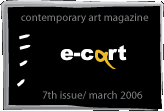 |
|
|
||||||||||||||||||||
 |
 |
 |
|
|||||||||||||||||||
| |
|
|||||||||||||||||||||
 |
|
|
|
|||||||||||||||||||
| |
|
|||||||||||||||||||||
 |
|
|||||||||||||||||||||
 |
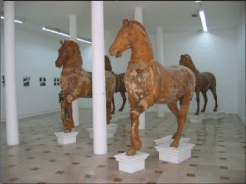 |
|
 |
|
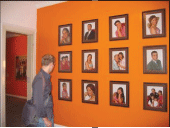 |
 |
|
|||||||||||||||
| |
 |
|
|
|||||||||||||||||||
| |
|
|||||||||||||||||||||
| |
|
|||||||||||||||||||||
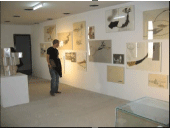 |
|
|||||||||||||||||||||
 |
|
|||||||||||||||||||||
| |
|
|
|
|||||||||||||||||||
| |
|
|
|
|
|
|||||||||||||||||
| |
|
|||||||||||||||||||||
| |
|
|
||||||||||||||||||||
| |
|
|
||||||||||||||||||||
 |
|
|||||||||||||||||||||
| |
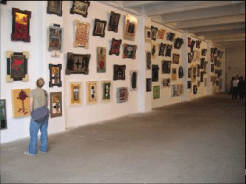 |
|
|
|||||||||||||||||||
| |
|
|||||||||||||||||||||
| |
|
|||||||||||||||||||||
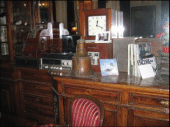 |
|
|||||||||||||||||||||
 |
|
|||||||||||||||||||||
 |
|
|||||||||||||||||||||
| |
|
|
|
|||||||||||||||||||
| |
|
|
|
|
|
|
|
|
|
|
|
|
|
|
|
|
|
|
|
|
|
|